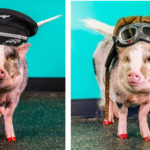Suppose your task is to design a stylish aviator outfit for pigs. How would you go about doing that? You might find it helpful to know that the 1616 edition of John Withals’s English-Latin dictionary, A Shorte Dictionarie for Yonge Begynners, notes that “Pigs fly in the ayre with their tayles forward.”
So you might opt for a tail-forward outfit?
Or perhaps something more stylish and in line with the 21st century?

How useful and versatile would the above outfit be? Does it serve its purpose?
At this point you might legitimately point out that pigs cannot fly and that therefore any talk of their outfits is, at best, a humorous distraction and, at worst, a waste of your time.
It turns out that the sartorial requirements of flying pigs are neither a waste of time nor a humorous distraction. In fact, we can use this case to make a cognitively relevant point.
Consider the two types of headgear in the photo below. Which of those would be better suited for our flying pigs during their aerial pursuits?

Chances are that you would have picked the aviator’s cap with the googles on the right. Unlike the pilot’s hat on the left it would be unlikely to get blown off (especially after you fasten the strap), and the goggles would offer protection for the eyes.
In other words, even though you know that pigs cannot fly, and even though the whole idea of designing aviator outfits is therefore impossible, you can make considered judgments about this reality-defying situation.
A recent article in the Psychonomic Bulletin and Review, by researchers Andrew Shtulman and Caitlin Morgan, reported several studies that provided evidence for the “graded impossibility” of events that violate our foundational knowledge and for people’s ability to differentiate between scenarios of different degrees of plausibility.
The idea that impossibilities come in 50 shades of plausibility has a long history in literature and art. For example, in the fictional world of Star Wars, the Jedi master Yoda teaches the Jedi apprentice Luke Skywalker to levitate stones before he teaches him to levitate a starship. Why? Because it surely must be easier to levitate a stone than an entire spaceship, even though we know that both are impossible.
This intuition is, however, paradoxical because by its very definition, the magic of levitation severs the known constraints of gravity and the link between an object’s weight and the ease with which it can be lifted.
So why is it easier to levitate a stone than a spaceship? Shtulman and Morgan suggested that we honor a range of causal principles when entertaining magical events. To test their idea, the researchers asked participants to review the curriculum for the Hogwarts School of Witchcraft and Wizardry of Harry Potter fame. Participants were presented with pairs of spells and were asked to evaluate how difficult those spells would be to learn (just think of Neville Longbottom and his difficulties!).
The pairs of spells were constructed that they both violated a deep causal principle but differed in relevant surface properties. For example, the spells “making a basketball levitate” and “making a bowling ball levitate” both violate the principle that unsupported objects fall, but they differ in their surface properties because heavier objects are more difficult to lift (by hand) than lighter ones. When the deep causal principle is suspended, would participants still honor features that were contingent on that principle?
The main manipulation the studies of Shtulman and Morgan was which causal principle was suspended in both pair members. The table below shows the 18 pairs that were used. The pairs spanned three domains—physics, biology, and psychology.

The results were straightforward and generalized across several ways of testing the pairs of spells. When participants had to choose one of the two pair members as being more difficult (but were not able to say “equally difficult”), their choices aligned around 85% of the time with the ordering implied by the features that were relevant to the underlying causal principles. Thus, levitating a basketball was considered easier than levitating a bowling ball by 85% of participants, and so on.
When people were given the option of saying “equally difficult”, this neutral option attracted quite a few responses but it did not change the fact that most participants were still responding above chance in alignment with the implied ordering.
In a further study, Shtulman and Morgan asked participants to generate justifications for their choice of spell. Those justifications were then coded for references to the target causal constraint. For example, the explanation “tap dancing involves rhythmic variation and a sequence of changing motions, whereas skipping is really one repeated motor program” for picking tap dancing as the more difficult spell to teach a cow would meet that criterion. Participants were found to cite the target constraint 96% of the time when their judgment of difficulty was aligned with the underlying constraint, compared to only 19% when their judgment was mis-aligned or both spells were considered equally difficult.
Similarly, when difficulty was judged on a continuous 7-point scale (from “slightly difficult” to “extremely difficult”), the mean difficulty ratings were again aligned with the ordering expected from the features that were relevant to the underlying causal principles. The alignment effect was observed even when spells were rated one-at-a-time in random order (i.e., no comparison stimulus was present) or when only one version of each spell was shown to a given participant.
The data of Shtulman and Morgan confirm a growing body of literature that products of the imagination, from fiction to superstition, are structured by causal constraints mandated by reality. We like our aliens to be symmetrical, with dual appendages and a head. And we would rather walk through a wall made of wood than a wall made of stone.
That said, if you are tempted to walk through a stone wall, you may do so at King’s Cross Station in London, which has an actual Platform 9¾ that takes you to Hogwarts—see below:

Article focused on in this post:
Shtulman, A. & Morgan, C. (2017). The explanatory structure of unexplainable events: Causal constraints on magical reasoning. Psychonomic Bulletin & Review. DOI: 10.3758/s13423-016-1206-3.
